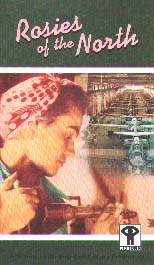 W
WThe Canadian Women's Army Corps was a non-combatant branch of the Canadian Army for women, established during the Second World War, with the purpose of releasing men from those non-combatant roles in the Canadian armed forces as part of expanding Canada's war effort. Most women served in Canada but some served overseas, most in roles such as secretaries, mechanics, cooks and so on. The CWAC was finally abolished as a separate corps in 1964 when women were fully integrated into the Canadian armed forces. The headquarters of the CWAC was based in Goodwin House in Ottawa.
 W
WVeronica Foster,, popularly known as "Ronnie, the Bren Gun Girl", was a Canadian icon representing nearly one million Canadian women who worked in the manufacturing plants that produced munitions and matériel during World War II.
 W
WMary Greyeyes Reid was a Canadian World War II servicewoman. A Cree from the Muskeg Lake Cree Nation in Saskatchewan, she was the first First Nations woman to enlist in the Canadian Armed Forces. After joining the Canadian Women’s Army Corps (CWAC) in 1942, she became the subject of an internationally famous army publicity photograph, and was sent overseas to serve in London, England, where she was introduced to public figures such as George VI and his daughter Elizabeth. Greyeyes remained in London until being discharged in 1946, after which she returned to Canada.
 W
WJean Suey Zee Lew is a Canadian veteran of World War II who was the only woman of Chinese-Canadian descent to serve in the Royal Canadian Air Force (RCAF). As a member of the RCAF Women's Division, Lee was stationed from 1942 to 1945 at the Royal Canadian Air Force Depot, Eastern Air Command, at Rockcliffe, Ontario.
 W
WLois Ruth Maxwell was a Canadian actress, best known for her portrayal of Miss Moneypenny in all the first fourteen Eon-produced James Bond films (1962–1985). She was the first actress to play the part. The films in which she played Miss Moneypenny were Dr. No (1962), From Russia with Love (1963), Goldfinger (1964), Thunderball (1965), You Only Live Twice (1967), On Her Majesty's Secret Service (1969), Diamonds Are Forever (1971), Live and Let Die (1973), The Man with the Golden Gun (1974), The Spy Who Loved Me (1977), Moonraker (1979), For Your Eyes Only (1981), Octopussy (1983), and A View to a Kill (1985). She did not appear in the 1954 and 1967 adaptations of Casino Royale, nor in the 1983 remake of Thunderball, Never Say Never Again, as the production was not Eon's, though she did, as a similar character, in the spoof O.K. Connery.
 W
WRosies of the North is a 46-minute Canadian documentary film made in 1999 by the National Film Board of Canada (NFB) and directed by Kelly Saxberg. The film recounts the story of the women at the Canadian Car and Foundry in Fort William, Ontario, who built fighter and bomber aircraft needed for the war effort in the Second World War. It also is the story of female engineer Elsie MacGill, who became known as the "Queen of the Hurricanes". The title of the film is an allusion to the wartime iconic image of Rosie the Riveter.
 W
WThe Royal Canadian Air Force Women's Division was a non-combatant element of the Royal Canadian Air Force (RCAF) which was active during the Second World War. The Women's Division's original role was to replace male air force personnel so that they would be available for combat-related duties. First called the Canadian Women's Auxiliary Air Force (CWAAF), the name changed to Royal Canadian Air Force Women's Division in February 1942. Women's Division personnel were commonly known as WDs.
 W
WThe Women's Royal Canadian Naval Service was an element of the Royal Canadian Navy that was active during the Second World War and post-war as part of the Royal Canadian Naval Reserve until unification in 1968. The WRCNS was in operation from October 1942 to August 1946.